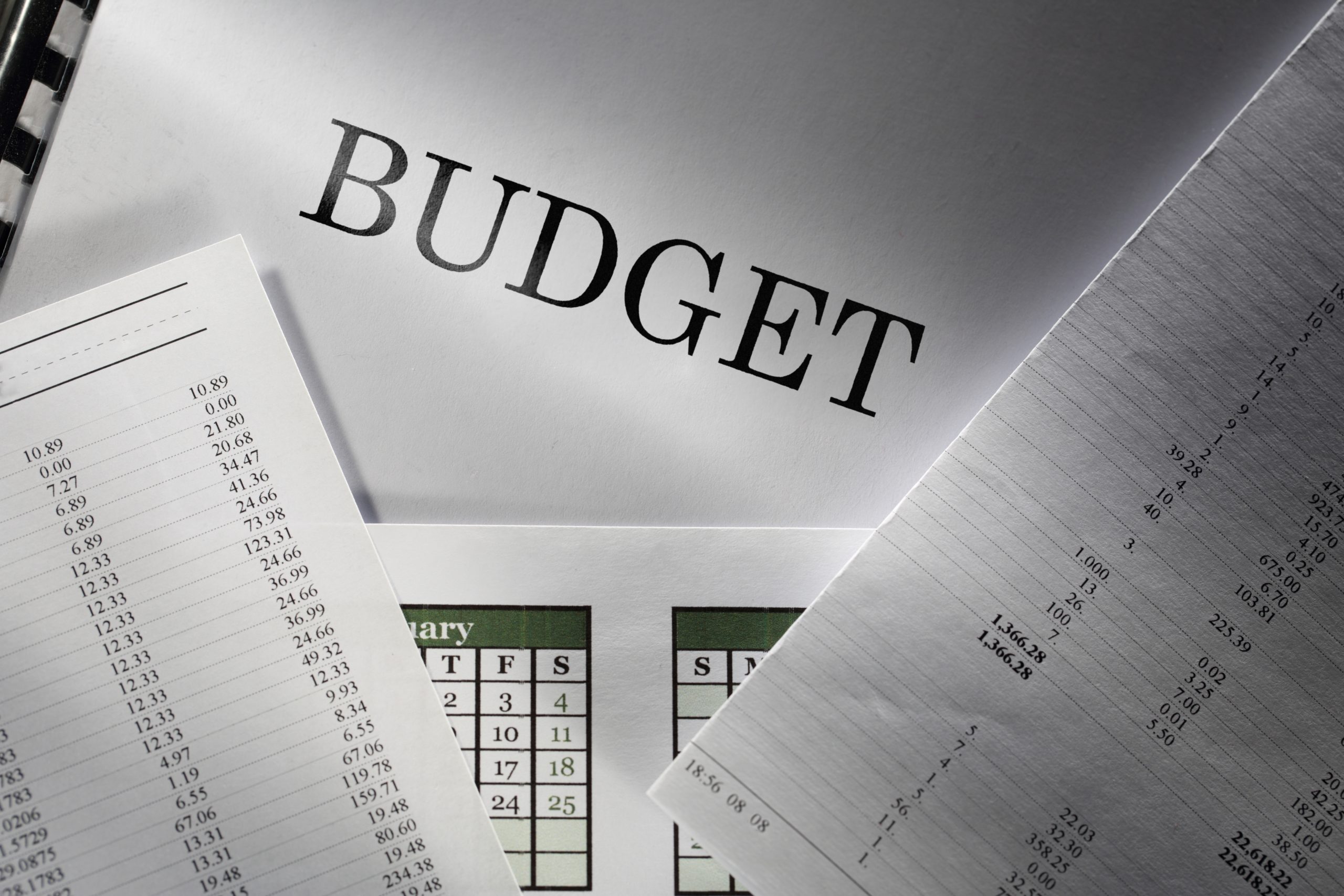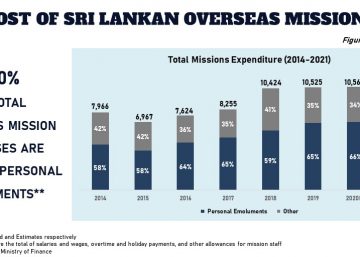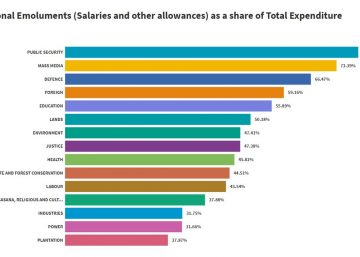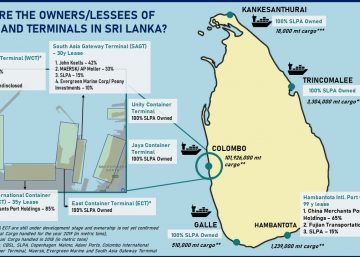Governments make attractive promises when presenting the Budget. However, successive Budgets have shown that making promises is easier than keeping them. The extent to which the present government will be able to keep its promises will depend on its ability to raise targeted revenues and align actual spending priorities to those that are stated. Making promises that are unlikely to be kept does not bode well for governance.
Previous Insights published by Verité Research titled ‘Who bleeds for the Budget?’ and ‘Agriculture and defence budgets reveal unstated priorities in policy’, demonstrated considerable variation between publicly declared sectoral Budget allocations and actual expenditure in previous years. The ‘actual’ priorities of the government, which can be different from the ‘stated’ priorities, are revealed when expenditures are cut to curtail the deficit as revenue comes in short of projections.
Education and health area clearly “stated priority” of Budget 2016, and this indicates an important shift in policy. The Budget also reveals that much of the extra spending in these sectors is towards capital expenditure (e.g. building and equipment) rather than recurrent (e.g. salaries and consumables). Budget 2016 contains a grand promise of increasing capital expenditure for health and education by over 120 percent all the way to Rs.210 billion.
This insight suggests that the priorities revealed in the first nine months of the present government dampens expectations that this promise will be delivered on as stated and that this is a problem of governance.
Popular demand has driven promises
Education and health are bedrock social expenditure in Sri Lanka because of the longstanding commitment and social expectation of universally free education and healthcare. The previous government saw a movement away from these commitments, with a steady decline in gross domestic product (GDP) share of allocations to these sectors (see Exhibit 1); however, this policy of neglect eventually began to reverse after a concerted protest campaign led by university academics with regard to spending on education.
In 2014, the previous government increased capital expenditure for education and health by 32 percent to Rs.74 billion and spent Rs.78 billion, which was even a little more. In the 2015 Budget, announced in November 2014, the government promised a further increase by 54 percent to Rs.120 billion. The subsequent presidential election campaign of the United National Party (UNP) and the current president was undergirded by a key popular promise to increase expenditure on education and health. Such promises were echoed in the party campaigns for the 2015 general election as well. The policy statement by the Prime Minister in November also suggested that improving access to high-quality education and health services would be a cornerstone of the government’s development policy framework.
In keeping with these promises, the Budget for 2016 has announced another leap (an increase of over 120 percent) in capital expenditure on education and health, to Rs.210 billion.
Source: Budget speeches – various years (P – provisional, B – budgeted)

Latest default on health and education promises
The interim Budget presented by the new government in January 2015 didn’t immediately increase the capital allocation on education and health, yet it held onto the November 2014 promise with a 55 percent increase in expenditure.
However, the actual expenditure in 2015 shows that the government has defaulted on this promise.
The budgeted spend was Rs.121 billion, while the actual spend was Rs.98 billion – an increase of 26 percent instead of the 55 percent promised (refer Exhibit 1). It is possible to see this as arising not just due to a shortage of cash but due to a mismatch between actual and stated priorities. This is because overall capital expenditure came out almost precisely on target: Rs.517 billion, against the budgeted Rs.520 billion. Although education and health were a “stated priority” in January 2015, capital expenditure in other sectors have been prioritized above it, and the actual spending on health and education faced an inordinate cut back.
Revenue shortage also drives default
The past practice of providing a rosy but unrealistic estimation of revenue growth has been repeated in the 2016 Budget as well: revenue is projected to increase by 38 percent.
When revenue targets are not met, the deficit balloons from what is budgeted. Bringing the deficit under control involves cutting expenditures. The actual rather than the stated priorities of the government are then revealed in the choices made on expenditure cuts.
For instance, the previous government was recognised for its prioritization of agriculture and irrigation. These were confirmed by Budget allocations between 2010 and 2013, which increased from Rs. 75 billion to Rs. 111 billion in the period. But an analysis of actual spending reveals otherwise. As revenues kept coming up well short of projections, the actual spending on agriculture and irrigation in 2010 was Rs. 69 billion and not the Rs. 75 billion stated in the Budget. Then, instead of increasing to the stated Rs.111 billion in 2013 the actual spends declined to Rs. 65 billion. The highest spend was in 2012, which still left a huge gap between the actual spend of Rs. 77 billion, against a stated Budget promise of Rs. 103 billion. However, while the agriculture and irrigation expenditure were cut drastically the defence budget remained buoyant – confirming that actual priorities were not aligned with what was stated in the Budget.
Weak prognosis for governance
The default on the 2015 budgeted promise with regard to education and health suggests that the present government is in danger of operating from the same playbook as the previous, this time in relation to education and health, instead of agriculture and irrigation. When revenues fall short of the rosy expectations set by the Budget, it is often capital expenditure that comes under pressure because recurrent expenditure commitments are more difficult to reduce (e.g. salaries need to be paid). Therefore, sectors that envisaged high increases in capital expenditures can expect to face cuts.
Over 80 percent of the new proposals in education and health are connected to capital expenditure. This is already a questionable priority for a government that is speaking of soft-infrastructure over hard infrastructure. But the defaults of 2015 and the overly bold promise for 2016 suggest that even this priority might stand to be compromised.
A previous Insight pointed out that budgeting was not just about money, it is about governance. There is an overarching promise held out by the present government to improve governance. The government’s longevity might well be predicated on how well it delivers on that promise. Reducing the gap between Budget promises and actual spending is an important aspect of living up to that larger promise of improved governance.
Verité Research is an independent think-tank based in Colombo that provides strategic analysis to high level decision-makers in economics, law, politics and media. Comments are welcome. Email publications@veriteresearch.org



